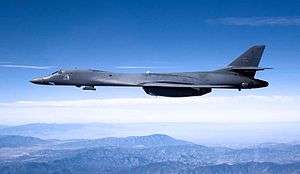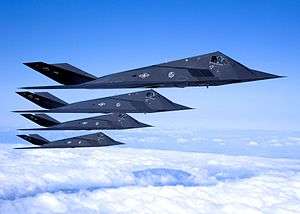410th Flight Test Squadron
| 410th Flight Test Squadron | |
|---|---|
|
Edwards Rockwell B-1B Lancer 85-0075
410th Flight Test Squadron - final F-117 four-ship formation flight over the Antelope Valley, March 28, 2007. | |
| Active | 10 March 1989-1 August 2008 |
| Country |
|
| Branch |
|
| Type | Squadron |
| Role | Flight Testing |
| Garrison/HQ | Edwards Air Force Base, California |
| Nickname(s) | "Baja Scorpions" |
| Tail Code | "ED" |
| Insignia | |
| 410th Flight Test Squadron emblem |
 |
| Aircraft flown | |
| Bomber | B-1B Lancer |
| Fighter | F-117 Nighthawk |
The 410th Flight Test Squadron (410 FTS) is an inactive United States Air Force squadron. It was last assigned to the 412th Operations Group, stationed at Air Force Plant 42, Palmdale Regional Airport, California. It was inactivated on 1 August 2008.
Overview
The squadron's primary mission throughout its lifetime was flight and acceptance testing of the F-117A Nighthawk stealth fighter and the B-1B Lancer bomber. Officially activated in March 1989 for B-1B flight testing, the mission of the unit was changed in 1993 when the B-1 testing was transferred to the 419th Flight Test Squadron and the squadron became the F-117A test squadron, assuming the mission of an inactivated classified unit formed in 1980 at Groom Lake, Nevada (Detachment 3, Air Force Flight Test Center)
History
B-1B Lancer testing
On 2 October 1981, President Ronald Reagan announced a Strategic Modernization Program (SMP), a key feature of which would be the procurement of 100 Long-Range Combat Aircraft (LRCA). The LRCA would later be designated as the B-1B Lancer.[1]
The first B-1B (82-0001) was assembled largely by hand and incorporated several sub-assemblies of the No 5 B-1A, which has been under construction when the B-1A program was cancelled in 1977 by President Jimmy Carter. It was rolled out from the Rockwell International assembly plant at Plant 42, Palmdale, California on 4 September 1984. It flew for the first time on 31 October 1984, crewed by Rockwell test pilots. It was a 3-hour, 20-minute flight which ended with a landing at Edwards AFB, California. The second aircraft was delivered on 7 July 1985. The B-1B was declared ready for delivery to the Strategic Air Command (SAC) barely eight months after its first flight.[1]
The initial B-1B assignment was to the 4018th Combat Crew Training Squadron at Dyess AFB, Texas, which was activated on March 15, 1985. The first operational squadron was the 337th Bombardment Squadron. The 100th and last production aircraft was delivered to the Air Force on 2 May 1988. At Edwards AFB, Air Force Systems Command formed and activated the 6510th Test Squadron on 10 March 1989 to provide operational testing of the B-1B weapons systems, software and components.[1]
When the aircraft reached operational squadrons, many shortcomings were discovered. Testing of modifications by the 6510th TS included modifications of the low-altitude range of the aircraft, which it was discovered to be well short of its proposed maximum un-refueled range of 7455 miles. The modifications increased the range of the aircraft from 1,300 nautical miles to over 3,000. Other modifications tested were problems with the terrain-following radar system, defensive avionics systems, fuel leaks, Central Integrated Test System, and F101 engine turbofan blade failures, which caused the grounding of the aircraft in December 1990.[1]
B-1 mission transferred to 419th Flight Test Squadron on 1 July 1991 and squadron ceased operations, however remained an active Air Force Systems Command organization.[2]
F-117A testing
Groom Lake/Area 51
In 1978, the preliminary testing of the Have Blue stealth aircraft was successfully completed, and William Perry, Under-Secretary of Defense for Research and Engineering in the Carter Administration, urged that the Air Force apply this technology to an operational aircraft. During November 1978, Lockheed was awarded a go-ahead contract to begin full-scale development of the project. The program was classified Top Secret/Sensitive Compartmented Information (TS/SCI) (i.e., "Black project"), and the code name "SENIOR TREND" was applied to it. In 1980, the SENIOR TREND Joint (later Combined) Test Force. (Detachment 2, R unit, 4450th Tactical Group) was established at Detachment 3, Air Force Flight Test Center consisting of a combination of Lockheed and USAF personnel as an acceptance test squadron for newly manufactured aircraft. Reportedly, after finding a large scorpion in their offices, the testing team adopted it as their mascot and dubbed themselves the "Baja Scorpions" and the scorpion symbol became the symbol of all F-117A testing.[3][4][5]
In June 1981, the first SENIOR TREND test aircraft (F-117 79-10780) (FSD-1) was delivered for testing. All deliveries of F-117 aircraft to Groom Lake were made by a C-5 Galaxy at night, with the aircraft offloaded and moved indoors to a hangar for final re-assembly. On 18 June 1981 the first successful flight was made by a Lockheed test pilot. During mid-1981 and early 1982, 10781 (FSD-2), 10782 (FSD-3), 10783 (FSD-4) and 10784 (FSD-5) were delivered to the Baja Scorpions for testing. There were usually four to six test flights (about half contractor and half USAF) for acceptance. They included systems checks, handling qualities evaluations, and low observable RADAR verifications. All flights of the aircraft were made at night without lights and the runway was only briefly illuminated to facilitate landings and takeoffs.[6]
The first production aircraft, 80-10785 was ready for its first flight on 20 April 1982. However, unbeknownst to anyone, the fly-by-wire system had been hooked up incorrectly (pitch was yaw and vice versa). Upon liftoff, the plane immediately went out of control. Instead of the nose pitching up, it went horizontal. The aircraft went inverted and ended up traveling backwards through the air. The pilot had no time to eject, and the aircraft flew into the ground. The aircraft was damaged beyond repair, but some of its parts could be salvaged.[4] Additional production F-117s were delivered during 1982. With operational testing completed, the aircraft were delivered to the Tactical Air Command (TAC) 4450th Tactical Group (4450th TG) which moved from Groom Lake to a new base at Tonopah Test Range Airport, Nevada in October 1983 where the plane could be brought up to operational readiness.[4][5]
On 11 July 1986, 81-10792 flew into a mountain near Bakersfield, California. The pilot appeared to have made no attempt to eject and was killed instantly, his aircraft disintegrating upon impact. A recovery team was immediately dispatched to the crash site, and the entire area was cordoned off. Every identifiable piece of the crashed plane was found and removed from the area to prevent them from falling into the wrong hands. The doomed aircraft had reportedly carried a flight data recorder, which is unusual for a USAF fighter. To deceive the public about the wreck, the recovery crew had taken the remains of a crashed F-101A Voodoo that had been at Groom Lake for over twenty years, broke them up, and scattered them throughout the area.[4]
Another accident occurred on 14 October 1987 when 83-0815 crashed in the Nellis range just east of Tonopah. Again, the pilot apparently made no attempt to eject, and was killed instantly. The official cause was never revealed, but fatigue and disorientation flying at night in almost total darkness may have both played a role. These two accidents, along with a need to better integrate the still-secret stealth fighter into its regular operations, forced the Air Force to consider flying the aircraft during daytime hours. This would in turn force the Air Force to reveal the existence of the aircraft. On 10 November 1988, the long-rumored existence of the "F-117 Stealth Fighter" was finally officially confirmed by the Pentagon.[4]
In 1990 the last F-117A (88-0843) was delivered. and the flight test squadron no longer had to perform acceptance flights at Groom Lake of new F-117A aircraft. However, the flight test duties still included flights for refurbished aircraft received from Lockheed.[6]
Palmdale
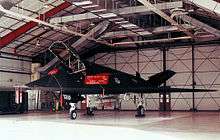
In February/March 1992 the nameless test unit moved from Groom Lake to Palmdale Plant 42 where Lockheed had produced the aircraft. Although most of the flight test activity (the infrastructure) moved from Groom Lake to Palmdale, some testing, especially RCS verification and other classified activity was still conducted at Groom Lake. There it came under the operational control of the Air Force Systems Command (AFSC) 2874th Test Squadron. The 2874th TS was soon re-designated as the 337th Test Squadron, With the establishment of Air Force Material Command (AFMC), the 337th was directed to come under the operational control of the 412th Test Wing at Edwards AFB. In February 1993, however, the test wing's Director of Operations proposed that the unit be established as the 410th Test Squadron. Headquarters AFMC agreed to this, and the "Baja Scorpions" test squadron was inactivated, its personnel and equipment merged into the 410th on 1 March 1993 and the squadron resumed operations.[1][6]
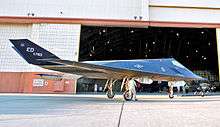
Flight testing continued at Palmdale throughout the operational life of the F-117. Some of the 410th FLTS's accomplishments include providing support for contingency operations during Operation Just Cause in 1989, Operation Desert Storm, Operation Allied Force and Operation Iraqi Freedom. On 1 August 2008, with the retirement of the F-117 from the inventory, the last aircraft of the 410th was flown to Tonopah TRA for permanent storage and the unit was inactivated.[7]
Heraldry
Bendy sinister wavy Argent and Gules the cypher X bendwise in base Or garnished Azure between four piles diminished in point bendwise of the like, a canton bendwise sinister of the fourth semé of eleven mullets White, all within a diminished bordure Yellow. Approved on 9 Aug 1990 (DFSC 91-02998).[8]
Lineage
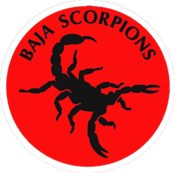
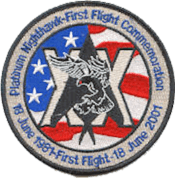
- Unofficial
- Tactical Air Command ("R"-Unit), 1980 (AKA "Baja Scorpions")
- Re-designated: Detachment 1, 57th Fighter Weapons Wing, 30 May 1989
- Inactivated 1 March 1993
- Personnel and equipment merged into 410th Test Squadron, 1 March 1993
- Official
- Designated 6510th Test Squadron, and activated, on 10 March 1989
- Ceased operations 1 July 1991
- Re-designated: 410th Test Squadron on 2 October 1992
- Resumed operations 1 March 1993, inheriting personnel and equipment from Detachment 1, 57th Fighter Weapons Wing
- Re-designated: 410th Flight Test Squadron on 1 March 1994
- Inactivated 1 October 2008
Assignments
- Unofficial
- SENIOR TREND Joint (later Combined) Test Force. (Detachment 2, R unit, 4450th Tactical Group), 1980
- 57th Fighter Weapons Wing, 30 May 1989
- Detachment 5, 2874th Test Squadron, February 1992
- Detachment 5, 337th Test Squadron, 1992 − 1 March 1993
- Official
- 6510th (later, 412th Test) Wing, 10 March 1989
- 412th Operations Group, 1 October 1993 – 1 October 2008
Stations
- Unofficial
- Detachment 3, Air Force Flight Test Center, 1980
- Nellis Air Force Base, Nevada**, 30 May 1989
- Air Force Plant 42, Palmdale Regional Airport, California, 27 March 1992 – 1 March 1993
- Official
- Edwards Air Force Base, California, 10 March 1989
- Air Force Plant 42, Palmdale Regional Airport, California, 1 March 1993 – 1 October 2008
[8] ** Note, Headquarters and personnel assigned to Nellis AFB, Operated from Det 3, AFFTC
Aircraft
- F-117 Nighthawk, 1981−2008
- F-117 aircraft not officially assigned to unit until 1 March 1993
- B-1B Lancer, 1989−1992
See also
References
![]() This article incorporates public domain material from the Air Force Historical Research Agency website http://www.afhra.af.mil/.
This article incorporates public domain material from the Air Force Historical Research Agency website http://www.afhra.af.mil/.
- 1 2 3 4 5 Rockwell B-1B Lancer
- 1 2 Rogers, Brian. United States Air Force Unit Designations since 1978. Hinkley, England: Midland Publications, 2005. ISBN 1-85780-197-0.
- ↑ 410th Flight Test Squadron
- 1 2 3 4 5 Developmental and Operational History of the F-117 Nighthawk
- 1 2 F-117 Serial Number Search
- 1 2 3 F-117 Testing
- ↑ 410th FLTS 'Baja Scorpions' closes historic chapter
- 1 2 3 4 5 AFHRA 410th Flight Test Squadron Lineage and History
